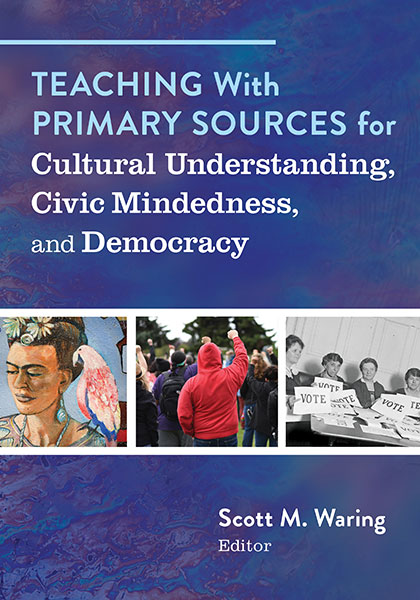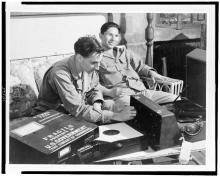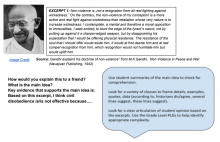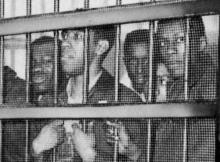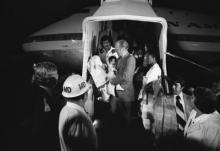Primary Sources and Inclusion
Purchase this new book on Teaching with Primary Sources from Teachers College Press.
This useful new volume is edited by Scott Waring, professor at the University of Central Florida and longtime leader in the National Council for Social Studies, and Library of Congress Teaching with Primary Sources Consortium. Several chapters feature ideas and examples on how to use primary sources to make classrooms fully inclusive.
Chapter 3: Inclusion of Students with Disabilities Through Primary Sources - Rich Cairn & Graham Warder
Rich Cairn and Graham Warder introduce a useful Framework for Inclusion: Physical, Pedagogical, and Narrative Accessibility, and explore the latter two frames in detail. (Emerging America provides detailed support. Follow the links below.)
Physical Accessibility
The Emerging America Accessing Inquiry clearinghouse offers an array of resources in its Know and Support Students page.
Pedagogical Accessibility
The authors apply the principles of Universal Design for Learning with a focus on history, civics and social studies, offering a variety of tools such as the Question Formulation Technique and graphic organizers such as the RAN Chart. Emerging America’s Inquiry Strategies page offers many more.
Narrative Accessibility
Cairn and Warder also explore the exemplary K-12 Disability History Curriculum: Reform to Equal Rights to integrate this vital history into a full curriculum. See also the portals: Disability History through Primary Sources, and Immigrant History through Primary Sources.
Image: Narrative Accessibility - Including stories of disabled activists throughout American history. Blind airmen. U.S. Air Force. Library of Congress. (1944). .
Chapter 5: Strengthen Language Proficiency Through Primary Source Inquiry: Supporting Multilingual Learners - Alison Noyes and Allison Audet
Alison Noyes and Allison Audet state their asset-based approach to language learning and commitment to employ Universal Design for Learning. Then they outline the further principles of Culturally Relevant Pedagogy and language-aware teaching, for example:
- “Teaching about patterns of language, from conversational cues to the ‘genres’ of different types of communication, lets students notice both how they themselves use language and how other authors use language.”
Further strategies and practices for language-aware teaching offered include: making language goals visible, use spoken language as a catalyst, and scaffolding for learners.
The chapter examines examples of teacher-tested lessons and materials from English Learner Collaborations, a project of the Massachusetts Council for the Social Studies, supported by a Library of Congress Teaching with Primary Sources grant.
Image: A screen shot from the exemplar lesson for English Learners on Civil Rights and civil disobedience from the English Learner Collaborations.
Chapter 7: When the Young Lead: The Legacy of Black Youth Civic Engagement in the Struggle for Civil Rights - Daniella Ann Cook, Jeffrey C. Eargle, and Vernon Turner
Daniella Cook, Jeffrey Eargle, and Vernon Turner present a case study of education for liberation to help students “think more critically about the social forces that shape our lives and think more confidently about their ability to react against those forces” - Charles M. Payne.
The chapter details a deeply interactive document walk which includes the primary sources: Claudette Colvin Police Report of Arrest in Montgomery (1955), Rock Hill Friendship 9 Photos, Children’s March Student Flyer, Stokely Carmichael’s “What We Want” Speech, and Jackie Robinson Letter to Roland L. Elliott, Deputy Special Assistant to President Nixon.
Image: The Friendship 9 Foundation. (1961).
Chapter 9: Deepening Civic Engagement With Project Based-Learning - Alex Goodell, Christopher Carter, and Sara Nachtigal
The authors explore why project-based learning is so effective, including its authenticity and relevance. Then they lay out a structure and key features of the approach, focused on pursuing genuine problems and exploring their context.
- “Project work culminates with a product or experience designed for an authentic audience.”
The chapter presents a case example based on an open-source unit students to explore and pursue a civic engagement project: Edcurious: Pa’lante: Onward with Art.
Chapter 10: ¡Sí, se puede!: Latinx Histories and Cultures Through Primary Sources - Bárbara C. Cruz.
“Latinx history is American history and is a blend of Indigenous, Spanish, and African ancestries pre-dating colonial America that merits studious consideration in any social studies classroom.” - Bárbara Cruz
Inclusive artifacts and other primary sources examined in the chapter include a short-handled hoe from an agricultural worker, the United Farm Workers logo, photos from the World War II era zoot suit riots, music recordings from Miriam Makeba to Celia Cruz to Rubén Blades, and contemporary art from Kathya María Landeros and others.
Image: Logo of the United Farm Workers. Library of Congress. (c1970).
Chapter 11: Teaching War Through Primary Sources: A Critical Refugee Studies Approach - Sohyun An
In this chapter, Sohyun An presents a lens on America through sources from the U.S. war in Vietnam in the 1960s and 1970s through refugee experiences across four decades. The diverse images include U.S. Air Force bombers, refugees in boats and on the island of Guam, and a news photo of President Ford greeting orphans from the 1975 Operation Babylift, and clipping of a 1989 story in which a white man shot and killed Cambodian immigrant children on a California playground. A story from 2019 examines the deportation of 126 Cambodian youths who had come to America as infants. Another story tells how Sunisa Lee, child of U.S. Hmong allies in the war, won Olympic gold in 2020 for the U.S.
For more about An, see the article, A ‘History of Exclusion, of Erasure, of Invisibility.’ Why the Asian-American Story Is Missing From Many U.S. Classrooms, Time Magazine online, March 30, 2021.
Image: President Ford holds an orphan baby from South Vietnam, brought to the U.S. in Operation Babylift. Gerald R. Ford Presidential Library & Museum. (1975).
Chapter 13: Locating Culture: Teaching With Primary Sources to Advance Culturally Responsive Teaching With Multilingual Learners - Andrea G. Kolb
With a riveting narrative, Andrea Kolb models an empowering journey of growth of professionals at the Center for Schools and Communities, grounded in listening and job-embedded solution-finding, as a learning community, over time. The chapter features excerpts from transcripts of teacher discussions, such as this one:
- Mr Taylor: I’m not gonna lie, I was really stuck on this idea of my middle school ELs “talking like historians” because I didn’t really think they could do that without being taught how to talk like historians…
- Mrs. Musselman: … Historians talk like historians whether it’s in Spanish or English or Urdu. …
- Mrs. Palmer: And really, at the heart of all this, is that students will only learn how to talk like historians if we let them talk. And I think what we learned is that there are two parts to that–(1) the language scaffolding tools that we all did with our source sets and (2) the cultural connections [we need them to make].
The teachers become conscious of the cultural frames that they bring to thinking and to consider best to activate the cultural frames of their students.
The chapter concludes with an in-depth vignette of a lesson on scarcity in which the teacher began with the 1970s oil and gas crisis yet quickly shifted to the student’s embodied knowledge of end-of-week cycles of scarcity at the local bodega grocery. That discussion led students to generate an overarching question, “Why is it more expensive to live in the city?” Which led students to deeper questions about the 1970s oil crisis and in turn change across decades and centuries.
Image: Cars lined up waiting for fuel. W. K. Leffler. Library of Congress. (1979).
More from the Book
Other chapters present a rich variety of strategies and tools for effective use of primary sources, on topics such as: Experiential Education, Document Based Questions, Higher-Order Thinking and Reasoning, Evaluating Global Democracy Building through Declarations of Independence, and using Graphic Memoirs.
See the companion volume The Educator's Handbook for Teaching With Primary Sources, October, 2023, Teachers College Press.



